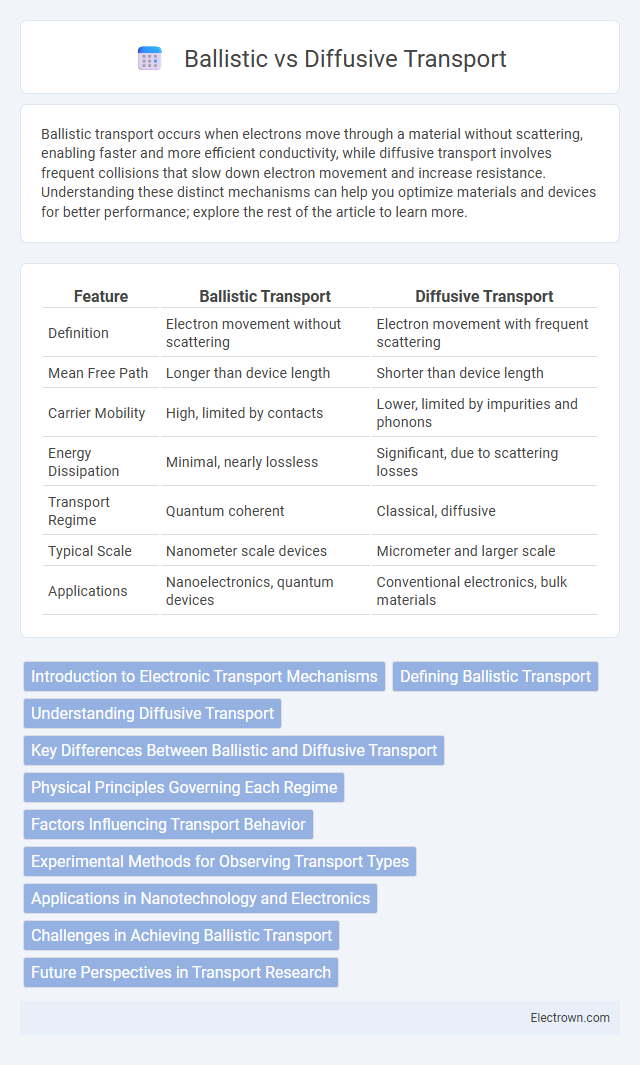Ballistic transport occurs when electrons move through a material without scattering, enabling faster and more efficient conductivity, while diffusive transport involves frequent collisions that slow down electron movement and increase resistance. Understanding these distinct mechanisms can help you optimize materials and devices for better performance; explore the rest of the article to learn more.
Table of Comparison
| Feature | Ballistic Transport | Diffusive Transport |
|---|---|---|
| Definition | Electron movement without scattering | Electron movement with frequent scattering |
| Mean Free Path | Longer than device length | Shorter than device length |
| Carrier Mobility | High, limited by contacts | Lower, limited by impurities and phonons |
| Energy Dissipation | Minimal, nearly lossless | Significant, due to scattering losses |
| Transport Regime | Quantum coherent | Classical, diffusive |
| Typical Scale | Nanometer scale devices | Micrometer and larger scale |
| Applications | Nanoelectronics, quantum devices | Conventional electronics, bulk materials |
Introduction to Electronic Transport Mechanisms
Electronic transport mechanisms in materials primarily involve ballistic and diffusive transport, which dictate how electrons move through a conductor. In ballistic transport, electrons travel through the material without scattering, maintaining high velocity and coherence over short distances typically in nanoscale devices. Diffusive transport occurs when frequent scattering events cause electron motion to become random, leading to resistance and energy dissipation, crucial factors in designing your electronic components for performance and efficiency.
Defining Ballistic Transport
Ballistic transport occurs when electrons or charge carriers travel through a material without scattering, maintaining their initial momentum over atomic or nanoscale distances. This phenomenon typically appears in high-quality crystalline structures or nanoscale devices where the mean free path of carriers exceeds the device dimensions. Ballistic transport contrasts with diffusive transport, where frequent scattering events dominate carrier movement, leading to random, resistive conduction behavior.
Understanding Diffusive Transport
Diffusive transport in materials involves the random scattering of particles such as electrons, phonons, or molecules, leading to a net movement driven by concentration gradients. This process is governed by Fick's laws, where particle flux is proportional to the negative gradient of particle density, resulting in a slow, stochastic migration through the medium. Understanding diffusive transport is critical for optimizing semiconductor device performance, thermal conductivity in materials, and mass transfer in chemical processes.
Key Differences Between Ballistic and Diffusive Transport
Ballistic transport involves electrons or particles moving through a medium without scattering, maintaining their momentum and energy over relatively long distances, which is common in nanoscale materials and devices. Diffusive transport, on the other hand, is characterized by frequent scattering events that cause particles to follow a random, zigzag path, leading to a gradual loss of momentum and energy and resulting in a net flow described by Fick's laws. Key differences include the mean free path being longer than the device size in ballistic transport, whereas it is much shorter in diffusive transport, which affects conductivity and device performance at the nanoscale.
Physical Principles Governing Each Regime
Ballistic transport occurs when electrons or particles move through a medium without scattering, maintaining their initial momentum and energy, typically at nanoscale dimensions where mean free path exceeds the channel length. Diffusive transport is governed by frequent scattering events that randomize particle trajectories, resulting in a net movement driven by concentration gradients and described by Fick's laws. The transition between regimes depends on the relation between characteristic length scales and mean free path, influencing electrical conductivity and carrier mobility in materials.
Factors Influencing Transport Behavior
Transport behavior in nanoscale materials is influenced by factors such as material length, temperature, and scattering mechanisms. Ballistic transport occurs when the carrier mean free path exceeds the device length, minimizing collisions and maintaining coherent motion. Diffusive transport dominates when frequent scattering events, due to impurities or phonons, disrupt carrier flow, resulting in random, resistive conduction.
Experimental Methods for Observing Transport Types
Scanning probe microscopy and time-resolved spectroscopy are prominent experimental methods for distinguishing ballistic from diffusive transport in nanoscale materials. Ballistic transport is identified by direct electron trajectory measurements showing minimal scattering, while diffusive transport exhibits random electron paths due to frequent collisions. You can analyze transport type by measuring conductance fluctuations or electron mobility under varying temperature and length scales to infer scattering mechanisms.
Applications in Nanotechnology and Electronics
Ballistic transport enables ultra-fast electron movement with minimal scattering, essential for high-speed nanoscale transistors and quantum computing components. Diffusive transport, characterized by frequent electron scattering, plays a critical role in thermal management and reliability of nanoelectronic devices. Understanding and controlling the balance between ballistic and diffusive transport improves performance in carbon nanotubes, graphene-based sensors, and advanced semiconductor materials.
Challenges in Achieving Ballistic Transport
Achieving ballistic transport faces significant challenges due to the need for minimizing electron scattering within nanoscale materials, which demands ultra-pure, defect-free substrates and precise fabrication techniques. Electron-phonon interactions and impurities introduce resistance and energy loss, disrupting coherent electron motion essential for ballistic transport. Overcoming thermal fluctuations and maintaining ballistic conditions over practical device dimensions require advanced material engineering and temperature control at the quantum scale.
Future Perspectives in Transport Research
Future perspectives in transport research concentrate on enhancing ballistic transport to achieve ultra-high-speed electron mobility in nanoscale devices, exploiting quantum effects for efficient energy transfer. Innovations in material science, such as 2D materials and topological insulators, exhibit promising characteristics to minimize scattering and extend ballistic transport regimes. Your understanding of these advancements will be crucial for developing next-generation electronics with unprecedented performance and energy efficiency.
Ballistic vs diffusive transport Infographic

 electrown.com
electrown.com